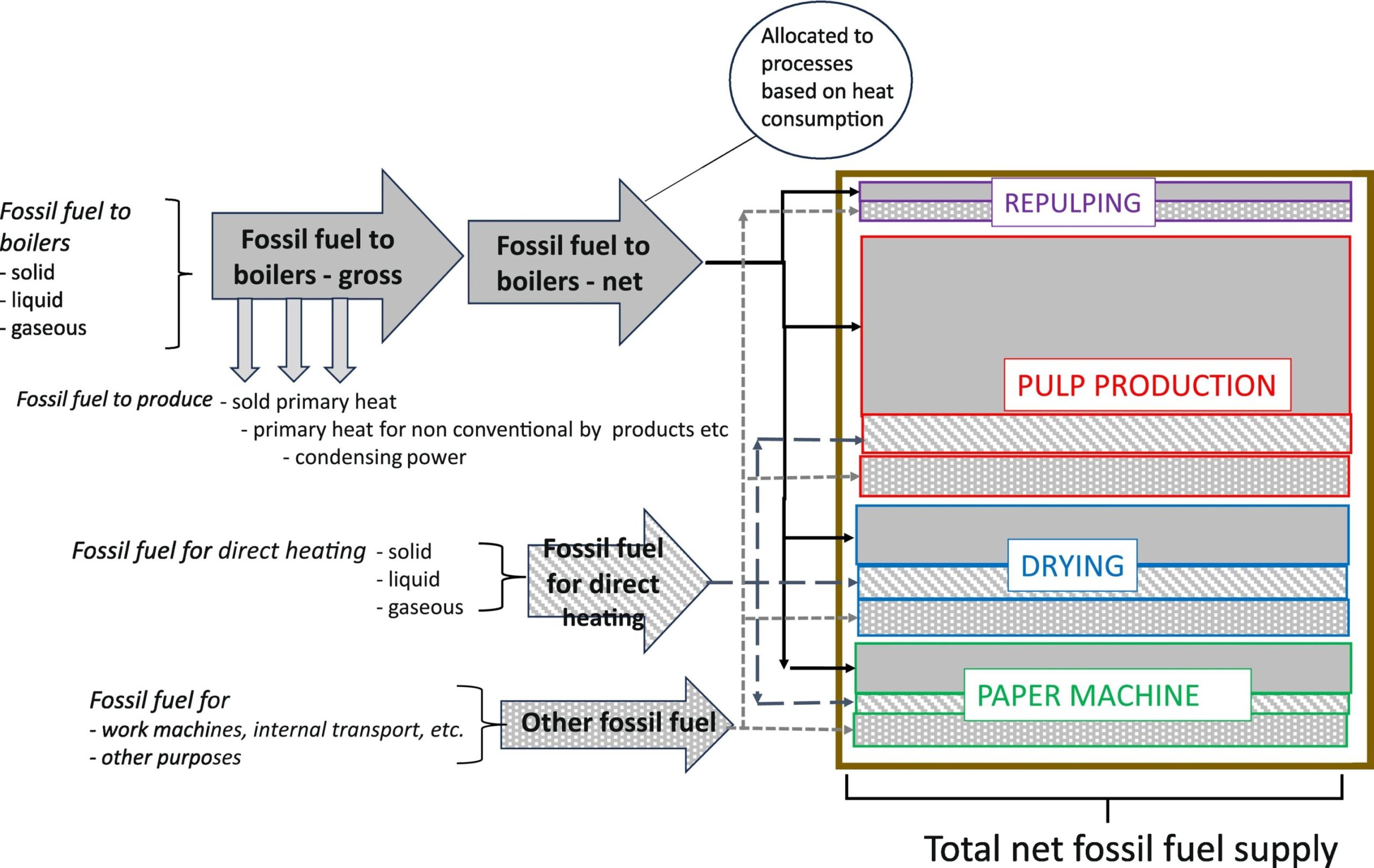Tech
Paper industry could become more energy-efficient with a new measurement method

The pulp and paper industry consumes large amounts of energy. But despite stricter EU requirements for efficiency improvements, there has been no way to measure and compare energy consumption between different companies in a fair way. In collaboration with the Swedish Environmental Protection Agency, researchers at Linköping University, Sweden, now present a solution that has great potential to be used throughout the EU.
“Even if this would contribute to increasing efficiency by one or a few percent only, this involves so much energy that it can make a huge difference,” says Kristina Nyström, Ph.D. student at the Department of Management and Engineering at Linköping University.
Globally, the pulp and paper industry accounts for 4% of energy used by the industrial sector. Through its Industrial Emissions Directive, the EU has set efficiency requirements for the industrial sector to reduce climate impact. An important tool for this is to make comparisons between factories within an industry—so-called benchmarking.
“But this has not been possible in the paper industry, because the mills have been so different that comparable results have not been achieved,” Kristina Nyström explains.
Therefore, the Swedish Environmental Protection Agency, assisted by Linköping University and Chalmers Industriteknik and in consultation with the paper industry, has developed a calculation method to enable comparisons. The method, which is presented in an article published in the journal Applied Energy, has great potential to be used throughout the EU, according to Olof Åkesson, former Swedish Environmental Protection Agency employee, who initiated the project.
The solution is to divide paper production into standardized processes such as actual pulp production, dissolution of purchased pulp, drying of pulp or paper production. These processes are common to enough mills for comparisons to be meaningful. In this way, companies can discover what in their processes works less efficiently compared to others, where improvements can be made and which actions would be most beneficial.
In addition, this method allows for more measures to be included in the energy efficiency efforts. One example is that companies are credited with the residual heat from manufacturing that is used in the surrounding community, such as the heating of homes or greenhouses.
Should this method gain ground, it could contribute to a changed approach to energy efficiency. At present, public agencies’ demands for energy audits often focus on details, which risks significant efficiency measures being overlooked.
“The benefit of making the pulp and paper industry more efficient is that this can reduce the use of fossil fuels and release raw materials, biofuels and electricity for other purposes,” says Åkesson.
With the involvement of researchers, public agencies and companies in the pulp and paper industry, chances are high that the method was designed in a way that is useful in practice. The collaboration between organizations can serve as a model for other industries wanting to develop their own measurement methods, according to Nyström.
Several companies that tested the measurement method have been positive, and it now needs to be spread and tested on a larger scale, the researchers say. The Swedish Environmental Protection Agency is working to develop the model, now also in dialog with public agencies and the pulp and paper industry in Finland.
More information:
Olof Åkesson et al, A calculation method enabling energy benchmarking in the pulp and paper industry: Adopting a methodology that bridge the research–policy implementation gap, Applied Energy (2025). DOI: 10.1016/j.apenergy.2025.126685
Citation:
Paper industry could become more energy-efficient with a new measurement method (2025, October 16)
retrieved 16 October 2025
from https://techxplore.com/news/2025-10-paper-industry-energy-efficient-method.html
This document is subject to copyright. Apart from any fair dealing for the purpose of private study or research, no
part may be reproduced without the written permission. The content is provided for information purposes only.
Tech
The Best Cyber Monday Streaming Deals With a Convenient Roommate’s Email Address

HBO knows you’re bored and cold. It wants you to Max and chill with Noah Wyle in scrubs. The company offers some of the best Cyber Monday streaming deals with a ridiculously low-priced $3/month offer for basic HBO Max (it’s the version with ads and 2K streaming, but still, super-cheap). Disney Plus and Hulu deals are bundled up for $5/month. Apple TV wants back in your life for $6.
Of course, this deal is only meant for new customers. Not boring ol’ existing customers. If you already have basic HBO Max, you’re already paying $11 for the same service, and HBO would like you to keep doing that. Streaming apps are banking on you being complacent and happy in your streaming life. Maybe they’re even taking you for granted.
Sometimes you can get the current deal just by threatening to cancel, or actually canceling, your account. Suddenly, you’re an exciting new customer again! Another method is by using an alternate email account (perhaps your spouse’s or roommate’s?) and alternate payment information as a new customer. If you do use a burner email (you did not hear this from me), check in on your favorite app’s terms of service to make sure you’re not in violation by re-enrolling with different emails. I’ll also issue the caveat that you lose all your viewing data and tailored suggestions if you sign up anew.
But times and wallets are tight! And $3 HBO Max sounds pretty good. After all, every middle-aged American man needs to rewatch The Wire once every five years or so—assuming he’s not the kind of middle-aged man who rewatches The Sopranos instead. Here are the current best streaming deals for Cyber Monday 2025.
Devon Maloney; ARCHIVE ID: 546772
Regular price: $80
Tech
Hong Kong FWA services market set for 9.6% growth | Computer Weekly

Analysis from GlobalData is forecasting that fixed wireless access (FWA) service revenue in Hong Kong is expected to increase at a “healthy” compound annual growth rate (CAGR) of 9.6% between 2025 and 2030.
The latest Hong Kong Total Fixed Communications Forecast set out to quantify current and future demand and spending on mobile services for the special administrative region of China. It noted that growth was being driven by Hong Kong’s extensive 5G network coverage and could also be attributed to local operators’ efforts to expand FWA services and position it as an alternative to traditional fibre broadband services for both residential and commercial sectors, meeting growing demand for high-speed connectivity in areas where extending fibre lines is challenging.
“High-density urban and suburban centres of Hong Kong create a strong business case for FWA services due to their cost-effective and rapid deployments without the complex infrastructure and civil work required for extending fibre-optic lines to such locations,” said Neha Misra, senior analyst at GlobalData.
“Competitive, feature-rich plans from the operators will also help drive its adoption over the forecast period. For instance, HKBN’s 5G Home Broadband Plan provides unlimited 5G broadband data (subject to a 300GB with a fair-usage policy) for HKD118 per month on a 24-month contract, along with a seven-day trial guarantee. The plan also includes a waiver of the HKD28 monthly administration fee and complimentary access to the basic HomeShield security plan.”
In addition to HKBN, the study noted that operators such as 3 Hong Kong and HKT are also using their extensive 5G networks to offer home broadband services, particularly in areas with limited fibre infrastructure. It cited HKT as recently having successfully deployed mmWave-based FWA to deliver ultra-high-speed internet to rural areas and outlying islands.
“Growing demand for FWA provides operators a strong revenue opportunity by expanding home and SME broadband without the high capital intensity of fibre roll-out,” Misra added. “By leveraging nationwide 5G coverage, introducing competitively priced service plans and bundling digital home services, operators can unlock higher ARPU [average revenue per user], accelerate market penetration in underserved areas and diversify beyond traditional revenues.”
GlobalData believes the Hong Kong government’s smart city initiatives will also open new opportunities for FWA, especially 5G FWA, which can deliver high-speed internet to power applications such as the digital economy, digital governance and e-health services, while supporting the city’s dense urban environment and digital transformation goals under the Smart City Blueprint 2.0.
The original blueprint was set out in December 2017, outlining 76 initiatives under six smart areas, namely Smart Mobility, Smart Living, Smart Environment, Smart People, Smart Government and Smart Economy. Blueprint 2.0 puts forth more than 130 initiatives that continue to enhance and expand existing city management measures and services. The new initiatives aim to bring benefits and convenience to the public so that residents can better perceive the benefits of smart city innovation and technology.
Tech
Prague’s City Center Sparkles, Buzzes, and Burns at the Signal Festival

And thanks to a mention in Dan Brown’s new novel, The Secret of Secrets, the festival has gained even more global recognition. Just a few weeks after the release of Brown’s new bestseller set in contemporary Prague, viewers were able to see for themselves what drew the popular writer to the festival, which is the largest Czech and Central European showcase of digital art. In one passage, the Signal Festival has a cameo appearance when the novel’s protagonist recalls attending an event at the 2024 edition.
“We’re happy about it,” festival director Martin Pošta says about the mention. “It’s a kind of recognition.” Not that the event needed promotion, even in one of the most anticipated novels of recent years. The organizers have yet to share the number of visitors to the festival this year, but the four-day event typically attracts half a million visitors.
On the final day, there was a long queue in front of the monumental installation Tristan’s Ascension by American video art pioneer Bill Viola before it opened for the evening, even though it was a ticketed event. In the Church of St. Salvator in the Convent of St. Agnes, visitors could watch a Christ-like figure rise upwards, streams of water defying gravity along with him, all projected on a huge screen.
The festival premiere took place on the Vltava River near the Dvořák Embankment. Taiwan’s Peppercorns Interactive Media Art presented a projection on a cloud of mist called Tzolk’in Light. While creators of other light installations have to deal with the challenges of buildings—their irregular surfaces, decorative details, and awkward cornices—projecting onto water droplets is a challenge of a different kind with artists having to give up control over the resulting image. The shape and depth of the Peppercorns’ work depended on the wind at any given moment, which determined how much of the scene was revealed to viewers and how much simply blown away. The reward, however, was an extraordinary 3D spectacle reminiscent of a hologram—something that can’t be achieved with video projections on static and flat buildings.
Another premiere event was a projection on the tower of the Old Town Hall, created for the festival by the Italian studio mammasONica. It transformed the 230-foot structure into a kaleidoscope of blue, green, red, and white surfaces. A short distance away, on Republic Square, Peppercorns had another installation. On a circular LED installation, they projected a work entitled Between Mountains and Seas, which recounted the history of Taiwan.
-

 Sports1 week ago
Sports1 week agoWATCH: Ronaldo scores spectacular bicycle kick
-

 Entertainment1 week ago
Entertainment1 week agoWelcome to Derry’ episode 5 delivers shocking twist
-

 Politics1 week ago
Politics1 week agoWashington and Kyiv Stress Any Peace Deal Must Fully Respect Ukraine’s Sovereignty
-

 Business1 week ago
Business1 week agoKey economic data and trends that will shape Rachel Reeves’ Budget
-

 Politics1 week ago
Politics1 week ago53,000 Sikhs vote in Ottawa Khalistan Referendum amid Carney-Modi trade talks scrutiny
-

 Tech6 days ago
Tech6 days agoWake Up—the Best Black Friday Mattress Sales Are Here
-

 Tech1 day ago
Tech1 day agoGet Your Steps In From Your Home Office With This Walking Pad—On Sale This Week
-

 Fashion1 week ago
Fashion1 week agoCanada’s Lululemon unveils team Canada kit for Milano Cortina 2026


















